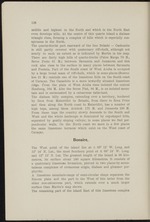| 1 |
 |
“...was carrying out trian-
gulations on the three islands and also preparing a topographical
map of Curagao.
Besides a general sketch-map of the roads on Curagao, given me
by Mr. Zelle, Head of the Public Works Department there, and
a sketch-map of a part of Aruba, given me by Mr. R. J. Beaujon,
I had no means of orientation in the three islands.
The lack of maps made itself still seriously felt in 1910 (i. e. 23
years after the publication of Martin’s book); hence my topogra-
phical determinations are mostly based on local information.
During the preparation of this flora the Topographical map of
Curagao, on a scale 1/200.000 has been finished; this excellent
map has still been helpful. Through the kindness of Prof. Grut-
terink I obtained a map of Aruba after the measurements of
captain Lens.
In order to get an impression of the size of the different islands
and of their mutual situation I used the map by H. M. van Straate *)■
1) West Indie Curasao, Bonaire en Aruba 1 : 300.000 samengesteld...”
|
|
| 2 |
 |
“...128
middle and highest in the- North and which in the North East
even develops hills. At the centre óf this quartz island a diabase
triangle rises, forming a complex of hills which is especially con-
spicuous in the North.
The quartz-diorite part eastward of the line Belashi — Cashuntie
is still partly covered with quaternary riff-chalk, although not
nearly to such an extent as is indicated by Martin in his map.
There are fairly high hills of quartz-diorite (Paloe Marga 78 M.,
Seroe Preto 61 M.J between Savaneta and Jamanota and this
rock also rises to the surface in many places between Savaneta
and Fontein. Part of the South coast of West Aruba is occupied
by a large broad seam of riff-chalk, which in some places (Boeroe-
koe 21 M.) reminds one of the limestone hills on the South coast
of Curagao. The Canashito is a more inwardly situated limestone
ridge. From the plain of West Aruba rises isolated the conical
Hooiberg, 164 M. Also the Seroe Plat, 94 M., is an isolated moun-
tain and is...”
|
|
